Menu
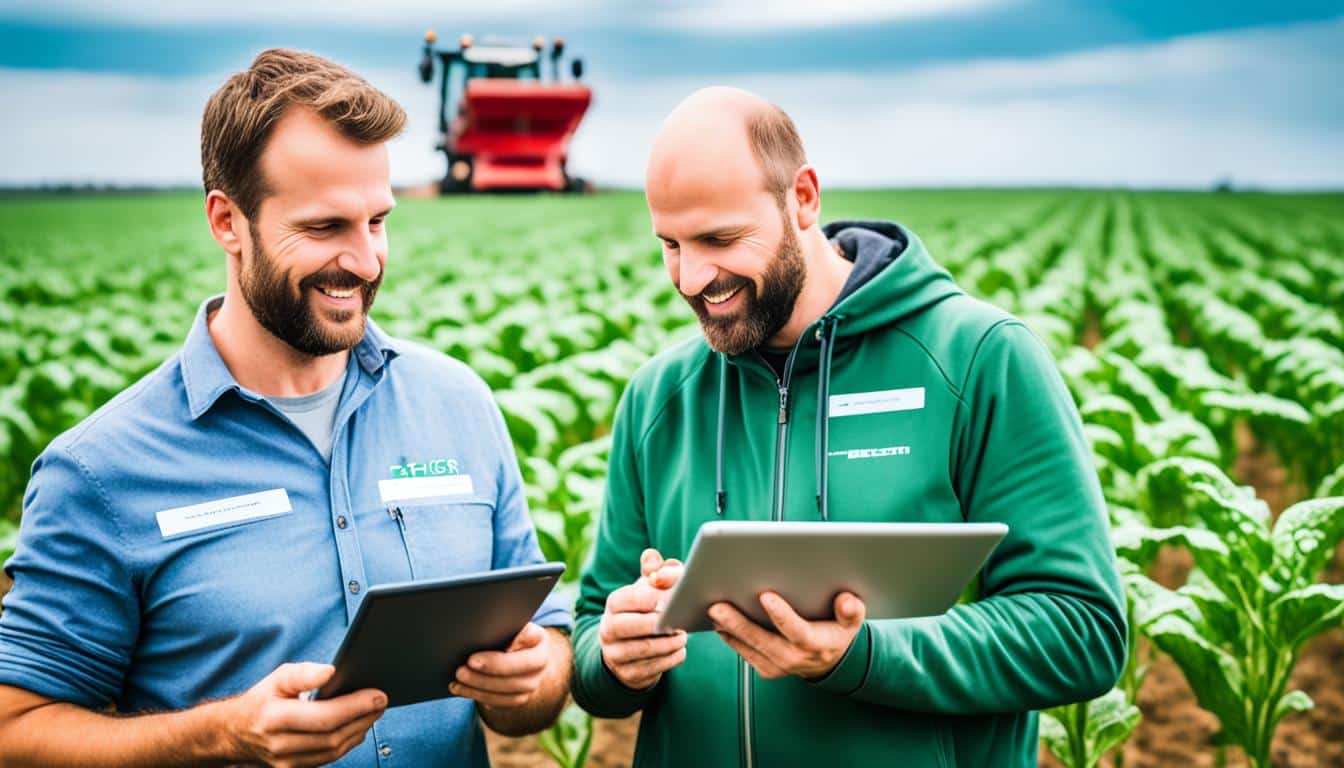
Did you know, in 2020 alone, US$30 billion went into over 3,000 agricultural and food technology deals? This was a 30% rise from 2019, showing a big interest in new farming and digital tech. Insignum AgTech is a great example, started by Kyle Mohler in 2019. The company got a $100,000 investment from the Purdue Ag-Celerator in January 2022. It shows how important working together with tech is in farming today.
Insignum AgTech joined forces with Beck’s, a top seed company in the U.S., to try new corn types in the best plant varieties for 2023. This move is part of a wider trend. Farmers and tech companies are working together more often to create advanced farming solutions. Renier Bueno, a leader from Ricult, played a key role. This trend aims to increase crop yield, improve money management, and help small farmers overcome financial challenges.
Some projects are working with big banks to create “farming scores”. These help bring financial support to more farmers, making the agriculture sector stronger. By using digital tools, these projects are not only making farming better but also solving problems faster. This helps banks avoid giving money to farmers who might not be able to pay back.
This drive for change is all about making life better for people. Giving farmers new tech and digital experiences is improving farming. It’s making farms more sustainable and productive.
Agritech is changing farming by quickly adopting new tech. This change is powered by more startups. They get investments from various sources worldwide. Using tech from companies like Deere & Co., farmers save resources and grow more food.
In the past, agritech made big steps that reshaped farming. Technologies like vertical farming made farming greener and more efficient. They save space, water, and cut down on pollution. Many startup owners are working hard to make farming sustainable.
Companies like Aquaconnect lead the way by using AI to help fish farmers. DeHaat gives farmers easy access to what they need and the latest weather info to keep up with growing food demands. These companies show what tech can do for farming.
Ricult uses machine learning to predict how much crops farmers will get. This helps farmers make the most of their land. Thanks to this approach, farms can produce up to 20% more food. This sets a high standard for other agritech businesses.
The agritech market is zooming towards a bright future. Experts think it could be worth around $43.37 billion by 2030. These exciting changes are making farming much better.
| Year | Market Value ($ Billion) | Key Drivers |
|---|---|---|
| 2024 | 24.08 | Sustainable Practices, Precision Farming |
| 2030 | 43.37 | Innovations, Technology Adoption |
Venture funds like AgFunder and The Yield Lab back up-and-coming agritech businesses, especially those into precision farming. This investment is crucial. It ensures farming stays at the cutting edge of technology, pioneering new solutions.
Today, farm holders face many barriers that slow down their work and make it hard to stay stable. To overcome these challenges, digital solutions are key. Developments like those from GROWERS have shown us how important technology is in farming since 2012.
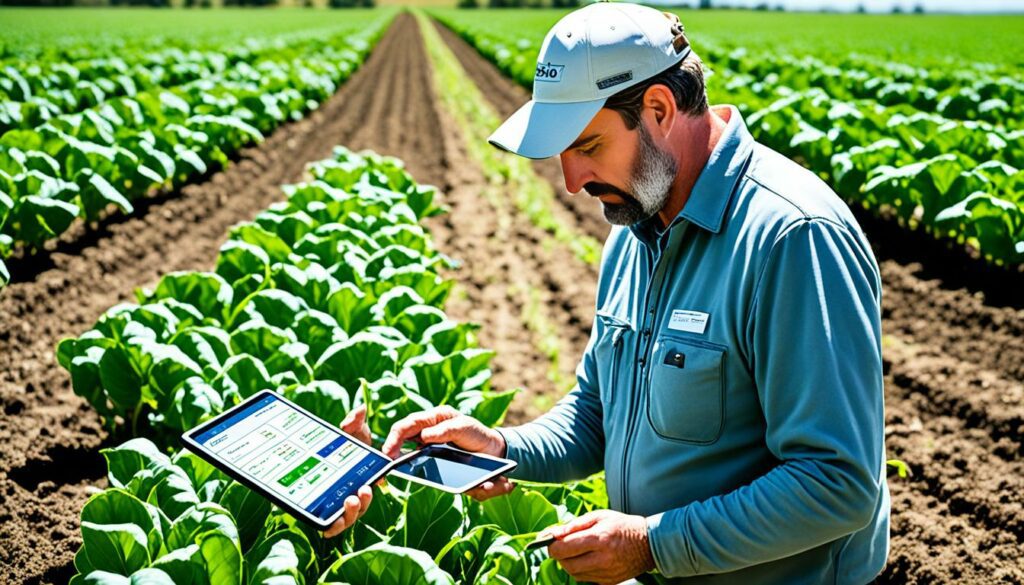
Farm holders deal with a lot, from changing weather to market ups and downs, and pressing financial needs. These problems can stop them from planning well or using their resources wisely. They need modern, quick strategies to face these issues head-on.
The GROWERS platform is leading the way with tech solutions for farming. It includes tools like GROWERS Rally, GROWERS App, GROWERS Guide, and GROWERS Connect. These help farmers in many ways:
With plans to grow in South America and Europe, GROWERS shows us how digital can lift rural projects. They aim for a level playing field where both big and small farms can thrive. Innovation like this turns digital into a game-changer.
These tech solutions empower farmers to do better in a tough industry. By linking them to everything they need – from supplies to markets – platforms like GROWERS boost profits and care for the land. The ongoing support from retailers and manufacturers nods to the big impact tech can have in agriculture.
Technology in farming has changed rural life, especially in poorer areas. It gives small farmers new ways to increase their harvests and look after the land. This leads to more money, less risk, and a big change in how farming is done.
In India, tools like KhetiBuddy help farmers sell directly to buyers. This means fairer prices without middlemen.
Across Africa, vertical farming is changing how food is grown in cities. This saves space, uses resources better, and helps grow more food with less harm to the planet. In people’s own gardens, smart sensors and watering systems make growing food easier. This helps fight hunger and increases the amount of fresh food available.
Technology boosts farming’s economics. Systems that watch crops closely, like sensors, drones, and data analysis, lead the way. John Deere & Co. is a big name here, helping farmers make better choices with data and new tools, all the while being kinder to nature.
The table below shows how tech helps the economy and farming:
| Technology | Benefit | Economic Impact |
|---|---|---|
| Precision Agriculture | Maximising yields and minimising waste | Projected market worth $16.35 billion by 2028 |
| Vertical Farming | Saves space and increases efficiency | Significant yield increase and resource conservation |
| Online Farmer Platforms | Direct connection to consumers, fair pricing | Empowering small-scale farmers and equitable food systems |
| Farm Automation | Increased yields, reduced labour time | Higher productivity and reduced costs |
Agri-tech entrepreneurs play a key role in rural areas. They help make farming stronger, fairer, and more able to survive hard times. As tech gets better, farming can be more for everyone, helping both local areas and the world.
Agritech partnerships are key in linking farmers with tech startups. They bring success to both sides. Traditional farming mixing with new technology faces some hurdles. Yet, many tales of triumph show the benefits of these innovative projects.
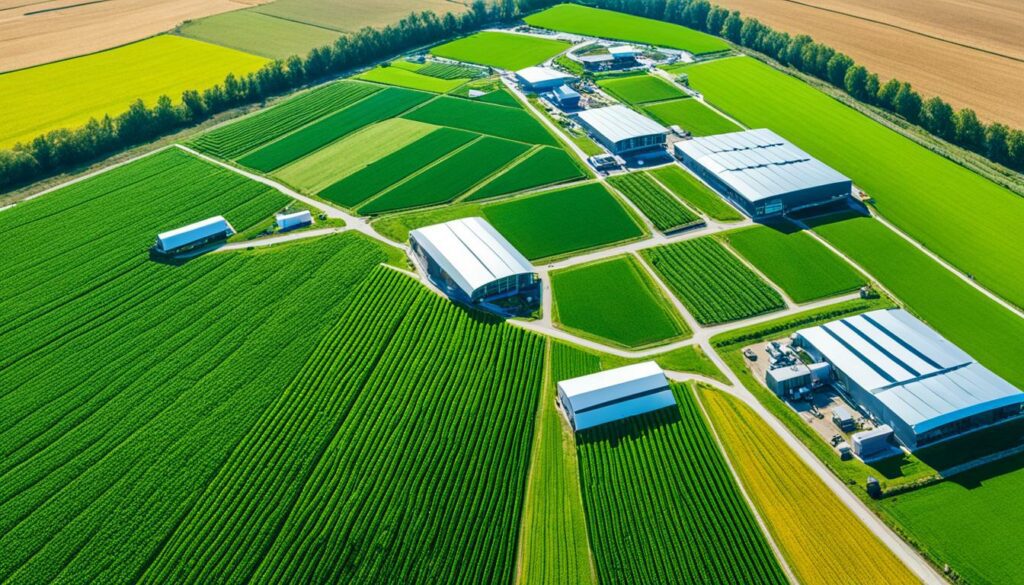
To work well together, it’s key to understand the farming world and its needs. Short-term gains of venture capital often don’t match the slow pace of farming. Ricult’s successful partnerships unite banks, mills, and farmers for everyone’s gain and future success. They use smart metrics and forecasts to improve the farming chain, making sure these new ventures prosper.
Ricult’s SaaS tools are a shining example of agri-tech done right. They forecast harvests and improve finances. Agtonomy also found success with a pilot in 2023, leading to major growth. Now, big players like Gallo and Treasury Wine Estates use Agtonomy’s tech. This proves the real gains of these partnerships. Such global projects are reshaping farming, especially in Africa. They meet challenges and push for sustainable farming. By giving farmers new tech and skills, these efforts boost economy and life in rural areas.
These partnerships spark new ideas and growth, showing the way for future agri-tech projects everywhere.
Innovation is making big changes in farming. It deals with today’s problems and tomorrow’s needs. The global market for precision farming will be worth $16.35 billion by 2028. Technologies like AI, machine learning, and IoT are leading the way.
These technologies help boost crop growth, save resources, and care for the Earth. For example, indoor vertical farms use 70% less water than usual. This shows the benefits of new farming approaches.
Farming methods are quickly improving with new tech trends. Precision agriculture uses new tools to make farming more sustainable, profitable, and productive. IoT and AI help farmers track their farms in real-time and predict future needs.
Innovations like laser scarecrows can cut down bird damage by 90%. This is a big win for farmers. Farm automation saves time and boosts crop production, making better use of resources.
The future of farming looks promising. Farming needs to produce more food by 2050 for a growing population. New technologies and practices are key to meeting this demand. For example, minichromosome tech can improve plant traits without altering genes directly.
Overall, farming tech aims to feed the world more sustainably and help farmers. Investments by the USDA in research and small businesses are paving the way for a better agricultural future.
| Statistic | Fact |
|---|---|
| Precision Farming Market Growth | $16.35 billion by 2028, 13.1% CAGR |
| Water Usage Reduction | 70% less in indoor vertical farming |
| USD LBV | ~$6 billion annual losses in the U.S. and Europe |
| Laser Scarecrows Efficiency | 70%-90% reduction in bird population |
| Farm Automation Impact | Reduced labour time, increased yields |
The link-up between farmers and tech startups is changing the game, bringing many benefits to farming. This partnership sparks new ideas. It boosts the amount of food being grown and how well farming looks after the planet.
This teamwork helps farmers fix their money troubles. With smart money solutions and knowing what might happen next, they’re making better choices. Less money is wasted, and farmers are finding it easier to keep their businesses going. The use of tech means farmers can grow more food, using fewer resources.

Working together, these parties are changing how farming works in many good ways:
Many stories of triumph show just how big an impact this teamwork can have. In 2023, Holganix made a massive $27 million in sales. Sentinel Fertigation was honored with a big award. Innatrix got $2.1 million in grants without giving up any ownership. And, AgLaunch Farmers, LLC is thriving, showing farmers can own a bit of these startup companies by helping out.
| Metric | Impact |
|---|---|
| Sales by Holganix | $27 million |
| Sentinel Fertigation Award | Nebraska Governor’s Award |
| Innatrix Grants | $2.1 million |
| AgLaunch Farmers’ Equity | Feedback and resources from nearly 50 members |
These efforts are proving that together, we can make farming better. This helps more people make a living from the land. The future of farming, thanks to farmers and tech startups working as one, looks brighter than ever.
Agri-tech is changing how we do farming, making it more sustainable. It includes things like precision tools and smart farming methods. Now, 80% of farmers use tech to make their work smarter, which cuts down waste by 40%. Vertical farming and IoT devices also help improve crop quality by 30% and use less space and water.
Many tech tools are helping farming be greener. Smart sensors and drones, for example, are increasing efficiencies by 20%. Vertical farming is another key method that offers more crops from the same area. 65% of farmers are using IoT to monitor and control their farms in real time, using resources better. 90% of them say these technologies have made farming both more efficient and better for the environment.
In dry areas, the use of smart farming has been crucial. For example, Bimbo and Heineken help farmers grow grains in ways that save water. This not only helps the planet but also makes farming more profitable. 85% of farmers working with these companies are making more money. The need for more meat worldwide has also pushed for sustainable solutions. Insect farming, for instance, uses less water and land than traditional farming, showing a new way to grow food sustainably.
| Technology | Impact |
|---|---|
| Smart Sensors and Drones | 20% increase in farm management efficiency |
| Vertical Farming | Significantly higher yields |
| IoT Devices | Real-time monitoring and control |
Small-scale farmers often struggle with limited resources and money. They also find it hard to keep up with new technologies. Yet, technology is changing farming for the better. It offers tools and knowledge to farmers. Things like mobile apps and information services give them weather updates and market prices. This helps them make smarter choices and grow more crops.
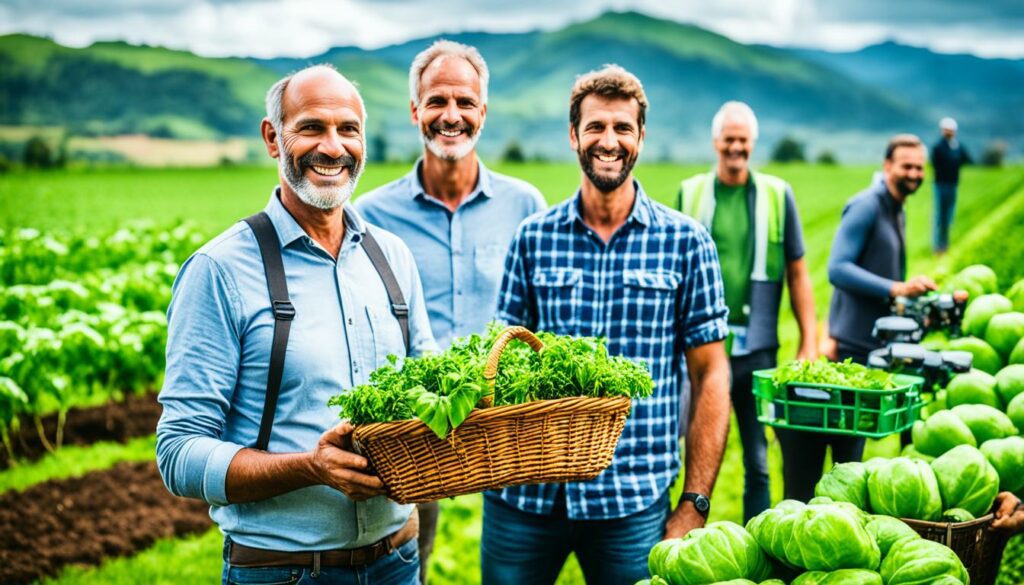
Technology helps farmers in many ways. For example, IoT and sensors check the soil’s health. They look at things like moisture, temperature, and nutrients. This helps farmers manage risks and care for their crops better. Drones can spot diseases and nutrient problems early. This is key to growing more food while wasting less.
There’s also technology like Cropslist that brings farmers together. It shares important market info. This helps them sell their crops better and make more money. Tech is not just about farming tools, but also connecting farmers and improving their skills.
Money help is important in getting tech to farmers. Programs like microfinance and insurance give farmers a boost. They can buy seeds, fertilisers, and tools. These programs protect farmers from losing everything if a crop fails. They support farmers in using new tech sustainably.
Adding tech to microfinance boosts farm output and income. It fights poverty and helps rural areas grow. But not everyone can benefit from these advances. Some farmers still struggle to understand tech and finance. We must keep helping farmers learn and grow with technology and financial support.
| Challenge | Solution |
|---|---|
| Limited access to resources | IoT and sensor technology |
| Financial constraints | Microfinance and insurance schemes |
| Technological advancements | Precision farming, drones, and mobile applications |
Apps like Cropslist link farmers directly to the market. This gives them great insight into what consumers want. It helps them grow better crops. It’s all about farmers and tech companies working together. This way, farmers can grow more with tech. Consumers get fresh, high-quality food. Everyone wins.
The world of digital solutions in agriculture is full of new, innovative products and services. These technologies are changing the old ways of farming. The market for precise agriculture is growing fast, expected to increase by 13% each year until 2030. This shows that the digital agriculture revolution is here to stay.
Today’s top agri-tech products are changing how we farm. They include things like predictive analytics software, AI for supply forecasts, and apps for farmers on the go. Agmatix is one example, offering data-driven solutions for farms. Their tech can predict outcomes by using lots of farming data, making better decisions possible. Axiom is another brand, making sure data from different places can be used the same way. This helps farmers worldwide. Digital Crop Advisor is also big, giving detailed crop nutrient advice. This ensures farmers get the most from what they put in.
Digital tools have made a huge difference in agriculture, especially in boosting crop yields. They’ve allowed better sharing of data and advice, such as with the Global Crop Nutrient Removal Database. Thanks to these tools, farmers can manage nutrients better, leading to huge improvements in crop production. Agmatix’s open data efforts have made it easier for everyone to find and use farming data. This has sparked more knowledge sharing and better solutions for farmers everywhere.
| Agri-Tech Product | Function | Impact on Farming |
|---|---|---|
| Predictive Analytics Software | Forecasting crop yields and supply | Dramatic increase in efficiency |
| Digital Crop Advisor | Nutrient recommendations | Optimised input and output ratios |
| Insights and Models Tool | Leveraging big data for predictions | Improved yield prediction accuracy |
Agricultural innovation plays a big part in making sure more people have access to financial services. A company called Ricult is using new technology to change how farming works. They are concentrating on plants like cassava, sugar cane, and rice. With their special software, they think they can help crops grow by 15-20% more than usual.
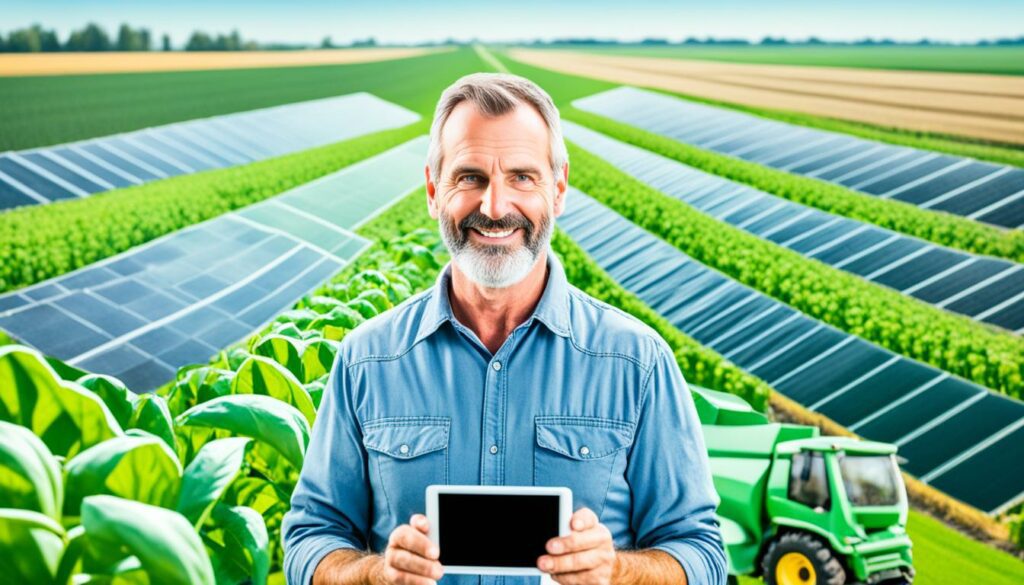
Ricult wants to help farmers get loans more easily without the loans becoming a problem. They are working closely with big banks in Thailand. They look at lots of information about a farm to give it a score. This score helps banks trust the farmers more. It means farmers can get the money they need to grow their businesses. This is all about making sure as many farmers as possible get financial help. It’s also about teaching them how to manage money better.
In Thailand, Ricult has already worked with some banks and agreed on how to share the money they make. They also sell special software services to different businesses in farming. These services help these businesses make plans that will work well.
Ricult also gives farmers useful information about what the weather will be like and how much they might sell their crops for. They work with companies that sell things farmers need at good prices. By doing this, they help farmers learn more about money and how it works.
Ricult’s use of digital technology is not just about good deals for farmers. It’s also about showing how important it is for farmers to understand money. This can help bring about a new way of looking at farming and money for farmers.
| Indicator | Value |
|---|---|
| Yield Increase Potential | 15-20% |
| Targeted NPL Reduction | |
| Farmers Reached in Rural Areas | 35,210 |
| Women Farmers Reached | 17,520 |
| Developers Trained for Digital Inclusion | 736 |
Data is key in today’s agri-tech, offering new insights and better ways for farmers to work. It plays a huge part in making farming more productive and earth-friendly.
Real-time data is changing the way farmers make choices. With big sets of data, farmers can predict yields and plan better. This helps cut down on losses after the harvest, which can be as high as 50%.
For instance, Deere & Co. uses tech to use resources better. In India, the Saagu Baagu project helped chilli farmers raise their profits by 18%. It also helps small farmers avoid unfair prices by giving them better market knowledge.
In farming, data is used in many ways to improve. Predictive analytics look at what crops will do well. Real-time monitoring makes sure food stays fresh. This is huge for things like insect farming, which is more efficient with less water and land.
Vertical farming uses data to grow more in less space. This helps in dry areas too by using less water. So, farming is becoming more efficient and sustainable, even with the weather against us.
| Data Utilisation Area | Impact |
|---|---|
| Predictive Analytics | 20% increase in crop yields |
| Vertical Farming | Significantly higher yields in minimal space |
| Insect Farming | Lower land and water usage |
| Precision Agriculture | Optimised resource utilisation |
This table shows how farming is changing with data. We’re moving towards more efficient and earth-friendly ways to farm. This means a big step forward for the world of agriculture.
AgriTech faces many obstacles, such as technical and socio-economic problems. These need tackling to fully unleash AgriTech’s value. With a market size over $3 billion anticipated by 2025, addressing these issues is crucial.
In many agricultural areas, a lack of good internet stops advanced tools from working. This includes AI for predictive insights. Also, tools in modern greenhouses, drones, and sensors need constant power, not always available in rural areas.
Robotics in AgriTech is great for tasks like harvesting but requires a big investment. Small farmers can’t always afford these tools. A joint effort from government and private sectors is key. They should improve rural tech and teach farmers how to use it.
AgriTech adoption is slowed by low tech knowledge and fear of new tools. Traditional farming models are hard to change. AgriTech startups must earn farmers’ trust to succeed.
Financial issues also slow AgriTech use. Despite many startups, few get noticed by authorities. Helping farmers access funds and using better tech for farming steps could help.
In seeking solutions, both technical and socio-economic challenges need tackling. Agricultural progress hinges on these efforts. By focusing on farmer needs and sustainable farming, AgriTech can truly benefit all. This approach lays the groundwork for a more robust agricultural future.
Working together, farmers and tech startups bring new ways to farm. They find solutions that are green, use less, and help farmers make more money. This teamwork also reaches more people in farming.
In the past, agri-tech grew a lot. Farmers started using technology more. Entrepreneurs made new tools for farming, like ones for being very precise and clever with data.
Early on, using AI and machines to see the future of crops was a big step. Companies like Ricult led this way. Their work has made farms better and more efficient.
Today, farmers meet many challenges. The weather can be very unpredictable. The market and money are tough too. Getting the right technology helps solve these problems.
There are many tech solutions for farming. There are apps that predict and help manage stock. They let farmers make safer deals, store goods better, and take less risk.
For places without a lot of progress yet, tech is changing things. It helps farms make more money. It reduces bad surprises and gets people to farm greener.
Yes. There are many stories of how tech changed farming for better in poorer places. It made work smoother and life healthier, with everyone gaining.
Tech in farming makes a big positive difference. It makes farms work better. It gets farmers more money and a better place in the market, growing whole communities.
Good strategies join farmers, techies, banks, and suppliers. They focus on what farms need and use smart tools for a smooth team effort.
Look at what Ricult and others did. They brought together banks, mills, and farmers. This made farms work better, less money lost, and helped small farmers much more.
Today, new tech trends include AI, learning from machines, and smart gadgets in the field. They make more and better crops, plus easy stock management.
Future farming will be smarter, greener, and make more money. Technology will be used in every clever way possible to meet farmers’ special needs.
Joining forces bring a lot of good. It powers up the farming world, makes it safer, feeds more around, and fights poor life.
Many good news exist from such work. Loans are safer now, farms work very well, and more people enjoy a better life thanks to farming that cares for all.
Tech in farming makes farming greener by using less nature’s gifts. This way, farms do more without hurting the world.
Big companies like Bimbo and Heineken show the way. With help from tech, they farm smarter, make less mess, and farm in a way that’s good for all.
For small farmers, tech is like a wise helper. It teaches about money, the market, and a way of farming that can last long and do well.
Great tools like smart programs, machines that know what stock will be needed, apps for farmers on the move, and systems that keep an eye on stock 24/7 make a huge difference.
Digital tools bring a big change to how much crops can grow. They’re very smart, letting farmers do the best for the earth and still harvest a lot.
New finance technology for farms is making a big difference. It uses clever data to show farms are worth investing in, making it easier for farms to grow with the money they need.
For agri-tech, data is pure gold. It helps make smart choices for farming. By looking ahead and at the now, it makes sure farms grow well and the earth stays happy.
Farmers use data to guess how much crop they will get, find what might go wrong, and see if they can make more money. It’s like a guide to wiser farming.
Setting up agri-tech can be hard if not everyone can connect well, if places don’t have good facilities, or the tech know-how is short. This makes it a bumpy path for tech to reach where it is needed most.
Not knowing much about tech and having little to spend stop some from using it. Also, old ways of doing things sometimes stand in the new tech’s way. To break through these, listening and new ways that put farmers first are a must.